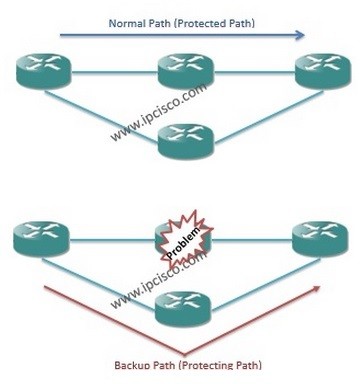- COURSES
- SPECIALS
- BLOG
- MEMBERS
- SHOP
- ABOUT
- ENROLL HERE

As you know, we can prioritize some of the traffic with MPLS-TE because of their nature. The high priority can be given to the voice and video traffic. Because they are fragile traffic types. During a failure normally these real time traffics send first and then the others. Like this, if a failure occurs in such a fragile traffic, this must be restored as soon as possible to provide the quality written in SLAs. This is done by MPLS Recovery.
For the ip networks, there are some Resiliency Mechanisms. We can classify these mechanisms like below:
Physical Redundancy: Redundant equipments
Protocol Layer Redundancy (IGP): Timers, hellos, different mechanisms etc. (reactive)
Here, the IGP protocol is fast but not enough for new applications and voice. And it is a reactive solution
After all, MPLS with RSVP-TE has very fast and proactive solutions. And they provide the expected fast recovery. These solutions are Secondary Paths and MPLS FRR (Fast Reroute).
In MPLS, LDP has also a resiliency mechanism. But as you know, LSP is dependant to IGP. So this is a limit for fast recovery.
Fast recovery can be done also for SONET by “SONET APS (Automatic Protection Switching)”.
In these article series mainly we will talk about MPLS Secondary Paths and MPLS FRR (Fast Reroute).
You can test your netowkirn gknowdge on All Network Quizes Page!
One of the choice for recovery using MPLS RSVP-TE is building a Secondary Path , that is standby. And leave this Secondary Path ready for any failure beside Primary Path. If any failure occurs on the protected path, then the standby Secondary Path take over the traffic. This is an end-to-end protection type that we will talk about detailly in the following posts.
